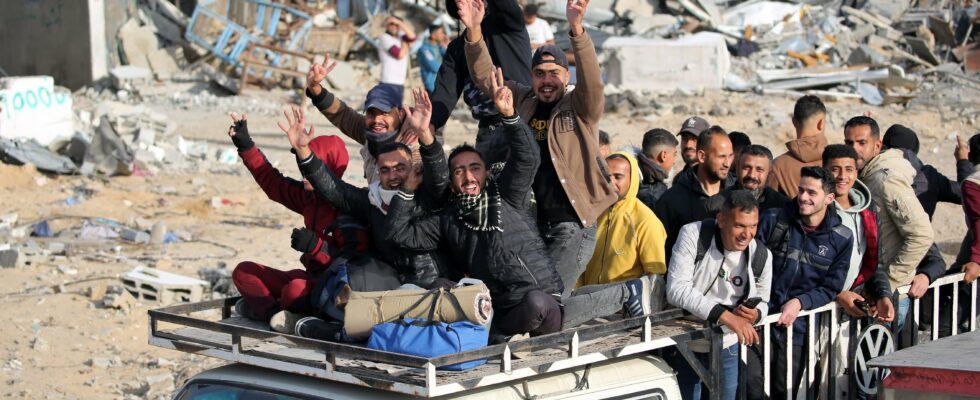The next six weeks will be crucial since they will confirm, or nip in the bud, the hope of long-term peace in the Palestinian territory. After 15 months of war in the Gaza Strip, the ceasefire agreement between Israel and Hamas, which provides for the release of Israeli hostages, finally came into force three hours late, this Sunday, January 19 .
Hostilities must cease and 33 Israeli hostages must be released during a first phase spread over six weeks.
A truce started on the wrong foot
The first hostages, three women, should be released this Sunday. However, the process got off on the wrong foot this morning, with Hamas having fallen behind in announcing the names of the three hostages, justifying it by “complications on the ground and the continuation of the bombings”.
While the guns were supposed to fall silent at 7:30 a.m. (Paris time), Israel delayed the application of the ceasefire, citing Hamas’ delay, and carried out new strikes in Gaza. Benjamin Netanyahu’s office ended up announcing the entry into force of the ceasefire at 10:15 a.m. (Paris time), information confirmed by the Qatari mediator.
A first exchange this Sunday
According to Doha, the list of three hostages released this Sunday therefore includes those “of three Israeli citizens, one of whom is also of Romanian nationality and the other of British nationality”. In exchange for the 33 Israeli hostages being reunited with their families, Israel said it would release 737 Palestinian prisoners. 95 Palestinian detainees should be released today, the majority women and minors, most of them arrested after October 7. Their release must take place after 1 p.m. (Paris time).
For its part, Egypt, which participated in the negotiations of the agreement, mentions “more than 1,890” Palestinian prisoners to be released during this first phase.
Three reception points at the border
The releases should then continue in cohorts. Three reception points for Israeli hostages have been set up on Israel’s southern border with Gaza, a military official said. The captives will be taken care of by doctors. The Islamist organization has pledged to hand over mostly living people during the initial phase of the deal, but it is unclear whether the captives will all be alive when they return, with the dead expected to be part of the final stage. of the process, explains it The World.
Two Franco-Israeli, Ofer Kalderon, 54, and Ohad Yahalomi, 50, are among the 33 hostages who can be released, according to Paris. They were kidnapped from Kibbutz Nir Oz with several of their children, released during an initial one-week truce in November 2023. Among the Palestinian prisoners expected to be released is Zakaria al-Zoubeidi, responsible for anti-Israeli attacks and former local leader of the armed wing of Fatah, arrested, imprisoned in 2019.
Israeli withdrawal from populated areas?
According to American President Joe Biden, who will officially give way this Monday, January 20 to Donald Trump, the first phase of the agreement also includes an Israeli withdrawal from densely populated areas in Gaza and an increase in humanitarian aid in the territory threatened by famine according to the UN. Egyptian authorities specified that the agreement provided for “the entry of 600 aid trucks per day”, including 50 fuel trucks.
One phase leads to another
It is during the first phase that the modalities of the second will be negotiated, which should allow the release of the last hostages, before the third and final stage devoted to the reconstruction of Gaza and the restitution of the bodies of the hostages who died in captivity.
The agreement thus provides for the launch of “a major plan for the reconstruction of Gaza”, affirmed the American president, without specifying the modalities. “A monitoring mechanism to monitor the implementation of the agreement will be set up in Cairo and will be managed by Egypt, Qatar and the United States,” the Prime Minister of Qatar also specified.
Thousands of Palestinians already returning
Even before the truce came into effect, thousands of displaced Palestinians responsible for their affairs took the road, amid the destruction, to return to their homes, in the north or south of the devastated Gaza Strip, according to images from AFP.
At midday, thousands of people were already arriving in Jabaliya from Gaza City, where residents discovered an apocalyptic landscape of rubble. Other return movements of the population were observed in the Rafah and Khan Younès sectors, in the South. On board vans or on foot, some all smiles make the V for victory, others share sweets or brandish the Palestinian flag.
After six weeks, the definitive end of the war?
Achieved on Wednesday by the mediators – Qatar, United States, Egypt – the agreement aims, according to Doha, to lead to the “definitive end” of the war. But Benjamin Netanyahu warned on Saturday that it was “a provisional ceasefire” and that his country retained “the right to resume the war if necessary, and with the support of the United States”.
Hostile to the truce, the party of Israeli Minister of National Security Itamar Ben Gvir (far right) announced this Sunday that it was leaving Benyamin Netanyahu’s coalition, which nevertheless still enjoys a majority in Parliament.
